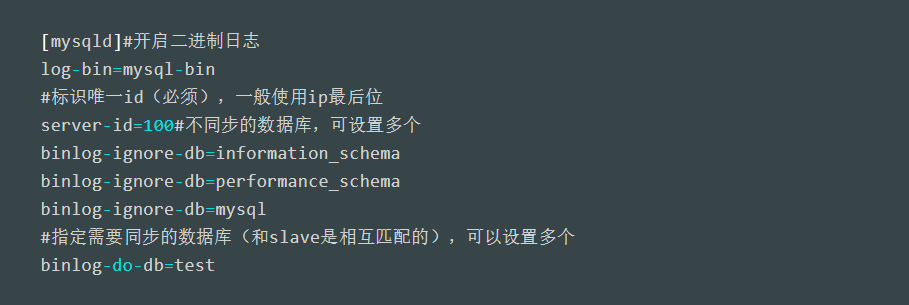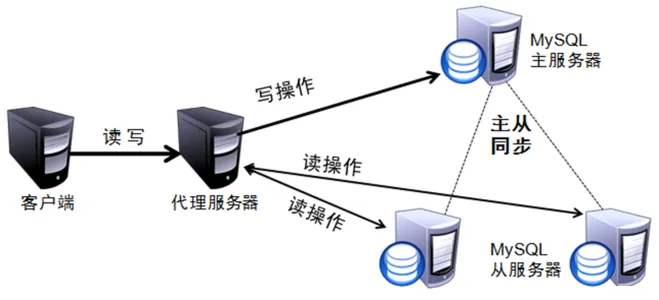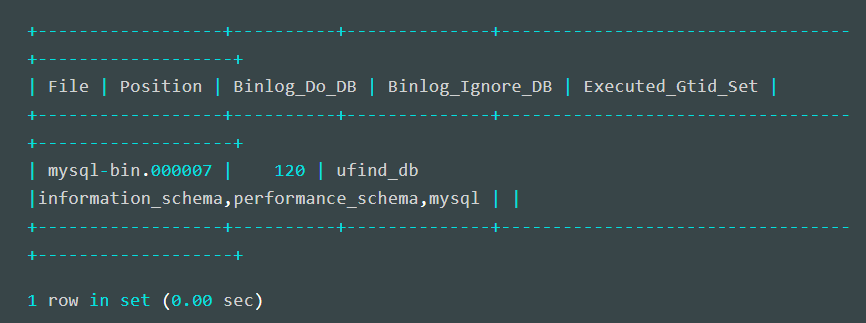主从复制:
当mysql数据库中的数据量过大,查询数据非常困难时,无论如何优化都会造成瓶颈,这时需要添加服务器设备来实现分布式数据库,实现多机热备份,实现多机热备,您必须首先了解主从数据库服务器版本的要求。主从mysql的安装和运行版本必须一致。因此,我们使用mysql自带的复制来实现mysql多机热备份的功能。mysql版本是5.7,用于演示。
读写分离:
它是将数据库上的读写操作分离,在多台服务器上共享读写压力,通常用于读远远大于写的情况。
读写分离的基本原则是让主数据库处理事务性的添加、修改和删除操作,而从数据库主要用于查询操作。数据库复制用于将事务操作导致的更改同步到群集中的从数据库。
当有更多的数据时,就会有很多对数据库的读写。只有一个写库,可以有多个读库。主从复制负责主库和多个读取库之间的数据同步。
配置环境
操作系统:两台CentOS 7.6的Linux系统(虚拟机)
数据库版本:MySQL 5.7
主服务器IP:192.168.1.100
从服务器IP:192.168.1.101

安装Mysql数据库
首先安装MySQL,新手按步骤进行操作(本站有专门的一篇教程教授如何安装MySQL,可在网站上方的搜索栏中搜索):
1、先检查系统是否安装有mysql
1 2 | [root@localhost ~]#yum list installed mysql*
[root@localhost ~]#rpm –qa | grep mysql*
|
2、查看有没有安装包
1 | [root@localhost ~]#yum list mysql*
|
3、安装mysql客户端
1 | [root@localhost ~]#yum install mysql
|
4、安装mysql服务端
1 2 | [root@localhost ~]#yum install mysql-server
[root@localhost ~]#yum install mysql-devel
|
5、开启端口
1 2 | vi/etc/sysconfig/iptables
-A INPUT -p tcp -m tcp –dport 3306 -j ACCEPT
|
6、重启防火墙
1 2 | systemctl restart iptables.service -- 重启防火墙
systemctl stop iptables.service -- 关闭防火墙
|
配置主(Master)数据库
1、修改数据库配置文件my.cnf
1 | <p>[root@localhost ~]# vi /etc/my.cnf<br></p>
|
修改配置文件
1 2 3 4 5 6 7 8 9 | [mysqld]#开启二进制日志
log-bin=mysql-bin
#标识唯一id(必须),一般使用ip最后位
server-id=100#不同步的数据库,可设置多个
binlog-ignore-db=information_schema
binlog-ignore-db=performance_schema
binlog-ignore-db=mysql
#指定需要同步的数据库(和slave是相互匹配的),可以设置多个
binlog-do-db=test
|

注:日志的存储容量大小可以根据你的服务器资源实际情况修改。

2、重启MySQL数据库服务(mysqld)
3、登陆MySQL数据库允许从库获得主库日志
1 | [root@localhost ~]# mysql -u root -p"你的密码"
|
注:第一次登陆是不需要输入root的密码的,有密码就要输入哦。
进入后做如下配置:
1 2 3 4 5 | #给从库放权限
mysql>GRANT FILE ON *.* TO'repl'@'192.168.1.101'IDENTIFIED BY'repl password';#创建用户
mysql>GRANT REPLICATION SLAVE ON *.* TO'repl'@'192.168.0.101'IDENTIFIED BY'repl password';#修改用户权限
mysql>selecthost,user,password from mysql.user;#查看是否修改成功
mysql>FLUSH PRIVILEGES;#刷新权限
|

4、重启MySQL服务,登录MySQL,查看主库信息
1 2 3 | [root@localhost ~]# service mysqld restart #重启mysql服务
[root@localhost ~]# mysql -u root -p #登陆mysql
mysql> show master status;#查看master状态
|
显示大概如下内容:

注:如果执行这个步骤始终为Empty set(0.00 sec),那说明前面的my.cnf没配置对,需要重新检查配置步骤。
配置从(Slave)数据库
1、修改从库的数据库配置文件
1 | <p>[root@localhost ~]# vi /etc/my.cnf<br></p>
|
将里面的内容更改为
1 2 3 4 5 6 7 8 9 10 11 | #开启二进制日志
log-bin=mysql-bin
server-id=101binlog-ignore-db=information_schema
binlog-ignore-db=performance_schema
binlog-ignore-db=mysql
#与主库配置保持一致
replicate-do-db=test
replicate-ignore-db=mysql
log-slave-updates
slave-skip-errors=all
slave-net-timeout=60
|

2、重启MySQL服务并登陆
1 2 | [root@localhost ~]# service mysqld restart
[root@localhost ~]# mysql -u root -p"你的密码"
|
修改:
#关闭Slave
mysql> stop slave; #设置连接主库信息
mysql> change master to master_host='192.168.1.100',master_user='repl',master_password='repl password',master_log_file='mysql-bin.000007', master_log_pos=120;#开启Slave
mysql> start slave;
注:上面的master_log_file是在配置Master的时候的File字段, master_log_pos是在配置Master的Position 字段。一定要一一对应
3、查看从库状态信息
1 | mysql> show slave status \G;
|
如下信息:
1 2 3 4 5 6 7 8 9 10 11 12 13 14 15 16 17 18 19 20 21 22 23 24 25 26 27 28 29 30 31 32 33 34 35 36 37 38 39 40 41 42 43 44 45 46 47 48 49 50 51 52 53 54 55 | ************************* 1. row *************************
Slave_IO_State: Waitingformaster to send event
Master_Host: 192.168.1.100
Master_User: root
Master_Port: 3306
Connect_Retry: 60
Master_Log_File: mysql-bin.000007
Read_Master_Log_Pos: 120
Relay_Log_File: localhost-relay-bin.000007
Relay_Log_Pos: 520
Relay_Master_Log_File: mysql-bin.000007
Slave_IO_Running: Yes//显示yes为成功
Slave_SQL_Running: Yes//显示yes为成功,如果为no,一般为没有启动master
Replicate_Do_DB:test
Replicate_Ignore_DB: mysql//上面的都是配置文件中的信息
Replicate_Do_Table:
Replicate_Ignore_Table:
Replicate_Wild_Do_Table:
Replicate_Wild_Ignore_Table:
Last_Errno: 0
Last_Error:
Skip_Counter: 0
Exec_Master_Log_Pos: 357
Relay_Log_Space: 697
Until_Condition: None
Until_Log_File:
Until_Log_Pos: 0
Master_SSL_Allowed: No
Master_SSL_CA_File:
Master_SSL_CA_Path:
Master_SSL_Cert:
Master_SSL_Cipher:
Master_SSL_Key:
Seconds_Behind_Master: 0Master_SSL_Verify_Server_Cert: No
Last_IO_Errno: 0
Last_IO_Error://如果为no,此处会显示错误信息
Last_SQL_Errno: 0
Last_SQL_Error:
Replicate_Ignore_Server_Ids:
Master_Server_Id: 2
Master_UUID: be0a41c0-2b40-11e8-b791-000c29267b6a
Master_Info_File:/usr/local/mysql/data/master.info
SQL_Delay: 0
SQL_Remaining_Delay: NULL
Slave_SQL_Running_State: Slave hasreadall relay log; waitingforthe slave I/Othread to update it
Master_Retry_Count: 86400
Master_Bind:
Last_IO_Error_Timestamp:
Last_SQL_Error_Timestamp:
Master_SSL_Crl:
Master_SSL_Crlpath:
Retrieved_Gtid_Set:
Executed_Gtid_Set:
Auto_Position: 01
rowinset(0.00 sec)
|
到此整个过程就算配置好了。现在我们可以在主服务器上创建一个表,然后在从服务器上查询刚创建的这个表是否存在。
运行测试
1、关于增删改查,主从数据不一致问题:
原因:在主库的logbin中的确有执行删除语句,但是在从库的logbin中却没有删除语句。
解决:使用 use database 命令选取当前数据库架构中的需要操作的数据库,然后再执行删除操作,同步成功。
2、查询binlog主从日志的方法
查看binlog全部文件,常用的几个命令
mysql>show binary logs;
mysql> show variables like 'log_bin%';#详细信息
mysql> show variables like 'binlog%';#查看binlog日志
mysql> show binlog events in'mysql-bin.000007';#或者使用mysqlbinlog,如果报错使用--no-defaults(使用全路径)
[root@localhost ~]# /usr/local/mysql/bin/mysqlbinlog --no-defaults /usr/local/mysql/data/mysql-bin.000019

3、手动清理master日志,最好关闭日志,在/etc/my.cnf
1 2 3 4 5 | #手动刷新日志
mysql> show master status;#删除全部
mysql> reset slave;#或 rest master;
#删除MySQL-bin.004
mysql> PURGE MASTER LOGS TO'MySQL-bin.004';
|

4、基本命令
1 2 3 4 5 | mysql> show master status;#查看主的状态
mysql> show slave status\G;#查看从的状态
mysql> show processlist;#查看mysql的进程状态信息
mysql> show master logs;#查看主的日志
mysql> reset slave;#(慎用,清除日志同时会清空从的配置信息)
|
原文地址:【架构师小跟班 www.jiagou1216.com】







